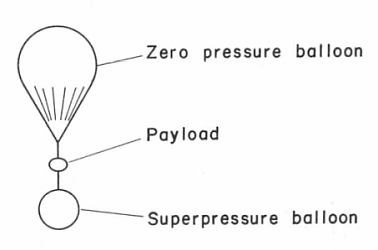Purpose of the flight and payload description
The Sky Anchor was a two balloon system developed and tested by the National Scientific Balloon Facility, during the 70's and 80's decade. It was based in an idea first envisaged in 1962 by Ash and Singer, two engineers of the Republic Aviation Corporation whom described a novel technique denominated "Boostrap System" for maintaining stable balloon flight for extended periods. Based on that concept in 1963, scientists at NCAR developed the first iteration of what they denominated the "Sky Anchor" system.
As we can see in the figure at left, it consisted of a zero pressure balloon inflated with sufficient helium to lift itself, the payload, and an uninflated superpressure balloon connected by a fixed length of cable. The uninflated balloon has a scoop to capture air during ascent. When the balloon approached the desired flight altitude, the vent was closed, and the balloon begun to become superpressured. As long as the air in the lower balloon was neither superpressured nor superheated, the balloon contributed neither lift nor extra mass to the system. But as the balloon became superpressured, the excess of air over that required to fill the volume provided an effective ballast. The superpressure required could be sufficient to compensate for both the original free lift and the added lift from daytime heating. Altitude would be higher during the day than at night because of the increase in superpressure. But some superpressure could remain at night to ensure stable flight.
The altitude at which a "sky anchor" system would stabilize was a function of the amount of air introduced into the anchor balloon. During the daytime, the balloon would normally rise about 5,000 feet above its nighttime float altitude. However, it could be held at nighttime altitude even during the day simply by pumping air into the balloon. Conversely, altitude could be reduced at any time by this method. Rather than its superpressure increasing, the balloon would simply descend to a lower altitude and maintain the same superpressure. Similarly, removal of air from the balloon would not decrease superpressure; the balloon would simply ascend until superpressure increases to the original value. It was thus quite feasible to control the flight altitude of a balloon over a wide range provided adequate pumping power was available and flight level was held below the altitude at which the zero pressure balloon would be fully inflated.
Details of the balloon flight
Balloon launched on: 8/5/1963
Launch site: Boulder, Colorado, US
Balloon launched by: National Center for Atmospheric Research (NCAR)
Balloon manufacturer/size/composition: Zero Pressure Balloon Top balloon: 18 ft. Diam. (0.5 mil.) + Anchor balloon 8 ft. Diam. Mylar
End of flight (L for landing time, W for last contact, otherwise termination time): 8/7/1963
Balloon flight duration (F: time at float only, otherwise total flight time in d:days / h:hours or m:minutes - ): 2 d
On August 5, 1963, a first proof of concept of the "sky anchor" system was launched from the NCAR grounds at Boulder, Colorado. The top balloon was a 0.5-mil polyethylene balloon, 18 feet in diameter, and weighing 4 pounds. The "anchor" balloon was an 8-foot bilaminated Mylar sphere weighing 2.5 pounds. Payload was a 0.8- pound timer set for 72 hours. The Mylar balloon by itself could carry this payload only to an altitude of 47,000 feet. However, the amount of air sealed into the Mylar balloon was metered to provide superpressure at 56,000 feet, with flight altitude computed to be 63,000 feet in daytime and 58,000 feet at night. The balloon system flew for two days at the design altitudes through two sunsets, a remarkable achievement for an "unballasted" zero pressure balloon. Failure to achieve the full 72-hour-flight time is attributed to gas loss in the zero pressure balloon, since it evidenced some gas loss priori to flight when held inflated over night.
External references
- Air is ballast in "Sky Anchor" concept Scientific Ballooning Nº 12, November 1963
- Development of the Sky Anchor Balloon System AFGL-TR-79-0053, Special Reports No. 217, 1978
11895If you consider this website interesting or useful, you can help me to keep it up and running with a small donation to cover the operational costs. Just the equivalent of the price of a cup of coffee helps a lot.


